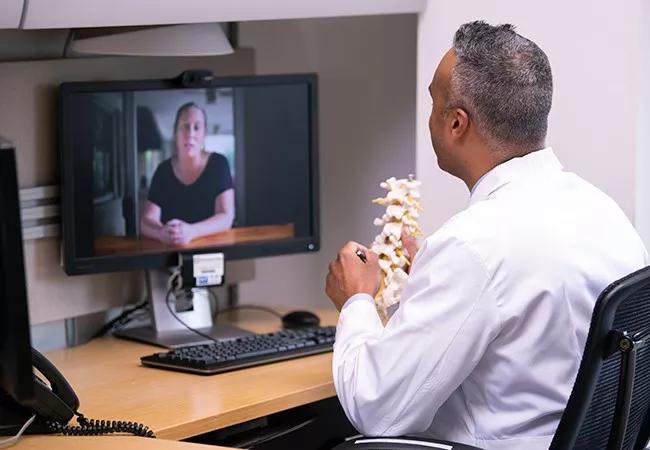The COVID-19 pandemic saw an increased usage of virtual visits, but what’s the long-term outlook for this model of care?

The COVID-19 pandemic and the ensuing social distancing measures impacted several aspects of healthcare for patients in pain, including an increase in virtual care. Cleveland Clinic’s Department of Pain Management was able to adapt its care model quickly and efficiently to meet the challenges of providing care virtually. Now more than a year after these initiatives were implemented, and with the benefit of hindsight, the department must determine which of their initiatives should remain in place going forward.
Advertisement
Cleveland Clinic is a non-profit academic medical center. Advertising on our site helps support our mission. We do not endorse non-Cleveland Clinic products or services. Policy
“The opportunity to maintain our relationships with patients through a combination of in-person and virtual care options is certainly the way that pain will be practiced both in the near-term and long-term,” says Benjamin Abraham MD, a pain medicine specialist in Cleveland Clinic’s Department of Pain Management. “Patients with chronic pain diagnosis often have a number of other comorbidities, so these patients may find that they’re well-served in maintaining continuity in the virtual environment.”
The Department of Pain Management had implemented a virtual healthcare program prior to 2020, but less than five percent of their patient encounters were completed via virtual health technologies. The pandemic forced the department to quickly scale up its virtual visit platforms, train additional staff and redesign internal workflows. At one point, the department was handling over 75% of its patient interactions virtually.
Of late, the department was able to identify several types of appointments in which the virtual model was successful and could have long-term viability. Follow-ups after procedures work well in the virtual environment. “There are opportunities to have interval follow-ups without the patient having to drive in; they can just connect on a video, and provide an update” explains Dr. Abraham. “Reviewing imaging via screen share is also a great teaching tool. “I often bring up images on the video platform and walk patients through the structures we are looking at, and explain the procedure using visuals; similar to how I would do it in the office.”
Advertisement
While Dr. Abraham admits “there were some growing pains at first — I think the patients, enjoyed the efficiency of it. This type of care model streamlines the encounter, and we end up having more time with the patient. We have the ability to connect family members into the conversation who may not be able to travel to an in-person appointment.”
Another benefit of virtual care is the possibility of expanding care to patients outside of Ohio. A Cleveland Clinic physician who works in Ohio likely has a medical license for the state of Ohio, but, as a specialty referral center, that physician may frequently see people all over the globe. “One of the programs that I believe has a great deal of potential is the Virtual Second Opinions program, which allows patients to engage in collaborative discussions out-of-state. We have partnered with Amwell, and through this program, we can open a conversation with both out-of-state and international patients. I think this is an opportunity is to reevaluate if state line boundaries really make as much sense as did prior to the pandemic as they do in this post-virtual world.”
Beyond reassessing state boundaries, another factor that will determine whether virtual care remains long-term is whether insurance companies continue to embrace virtual visits. “Before the pandemic, virtual visits were rarely a covered benefit” explains Dr. Abraham. “Now that patients are showing interest, the insurance companies are also covering some virtual encounters. Often the out-of-pocket costs are similar to what they’d see in an in-person visit. I think that it behooves us as caregivers to show that our outcomes are just as good when we’re taking care of patients in a virtual environment.”
Advertisement
How technology develops and adapts to this new environment —both in terms of the breadth of offerings and accessibility — will also play a major role in determining the effectiveness of virtual visits going forward. For pain patients, this includes potentially incorporating assessment devices that they can use at home, such as mobility trackers or virtual reality glasses to facilitate rehabilitation. “Virtual care has several benefits for the patient, the family members and the physician and the insurance carriers, but we need to be thoughtful about how we expand it. There are, hopefully, lots of interesting things coming down the pipeline for virtual pain care post-pandemic, and I hope we don’t lose this momentum,” says Dr. Abraham.
Advertisement
Advertisement

Digital “tripwires” detect and respond to malicious activity, boosting cybersecurity maturity

Effective provider training strategies incorporate multi-modal delivery

Thoughtful collaboration, data-driven decisions and effective change management lead to significant savings

A thoughtfully designed program to elevate participants’ leadership potential

Clinical input is integral to technology implementation and adoption strategy

Advancing technology makes informatics expertise essential

Integrating technology is more than product delivery

Combined expertise, collaboration and technology lead to several improvements